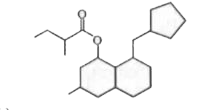Identify and indicate the presence of chirality, if any in the following molecule. How many stereoisomers are possible for those containing chiral centres? 3-Bromopent-1-ene.
To determine the chirality and the number of stereoisomers for 3-bromopent-1-ene, we can follow these steps:
Step 1: Draw the Structure
First, we need to draw the structure of 3-bromopent-1-ene based on its IUPAC name.
- The name indicates that there are five carbon atoms (pent).
- The "1-ene" indicates that there is a double bond between the first and second carbon atoms.
- The "3-bromo" indicates that there is a bromine atom attached to the third carbon.
The structure can be drawn as follows:
CH3−CH=CH−CH2−CH3∣Br
Step 2: Identify Chiral Centers
Next, we need to identify if there are any chiral centers in the molecule. A chiral center is a carbon atom that is attached to four different groups.
- In our structure, the third carbon (C3) is attached to:
- A bromine atom (Br)
- A hydrogen atom (H)
- A carbon chain (C2H5 from C4)
- A carbon chain (C1H3 from C2)
Since C3 is attached to four different groups, it is a chiral center.
Step 3: Determine Stereoisomers
Now that we have identified one chiral center, we can determine the number of stereoisomers. The number of stereoisomers can be calculated using the formula:
\( \text{Number of stereoisomers} = 2^n \)
where \( n \) is the number of chiral centers.
In this case, we have:
- \( n = 1 \) (one chiral center)
Thus, the number of stereoisomers is:
\( 2^1 = 2 \)
Conclusion
In summary:
- The molecule 3-bromopent-1-ene has one chiral center.
- Therefore, it can have 2 stereoisomers (optical isomers).
First, we need to draw the structure of 3-bromopent-1-ene based on its IUPAC name.
- The "1-ene" indicates that there is a double bond between the first and second carbon atoms.
- The "3-bromo" indicates that there is a bromine atom attached to the third carbon.
CH3−CH=CH−CH2−CH3∣Br
Next, we need to identify if there are any chiral centers in the molecule. A chiral center is a carbon atom that is attached to four different groups.
- A bromine atom (Br)
- A hydrogen atom (H)
- A carbon chain (C2H5 from C4)
- A carbon chain (C1H3 from C2)
Now that we have identified one chiral center, we can determine the number of stereoisomers. The number of stereoisomers can be calculated using the formula:
\( \text{Number of stereoisomers} = 2^n \)
where \( n \) is the number of chiral centers.
- \( n = 1 \) (one chiral center)
\( 2^1 = 2 \)
In summary:
- The molecule 3-bromopent-1-ene has one chiral center.
- Therefore, it can have 2 stereoisomers (optical isomers).
Topper's Solved these Questions
- HALOALKANES AND HALOARENES BOOK - ICSECHAPTER - HALOALKANES AND HALOARENES EXERCISE - EXERCISE (PART - II DESCRIPTIVE QUESTIONS) (SHORT ANSWER QUESTIONS)
94 Videos
- HALOALKANES AND HALOARENES BOOK - ICSECHAPTER - HALOALKANES AND HALOARENES EXERCISE - EXERCISE (PART - II DESCRIPTIVE QUESTIONS) (LONG ANSWER QUESTIONS)
65 Videos
- HALOALKANES AND HALOARENES BOOK - ICSECHAPTER - HALOALKANES AND HALOARENES EXERCISE - EXERCISE (PART - I OBJECTIVE QUESTIONS)
1 Videos
- GENERAL PRINCIPLES AND PROCESSES OF ISOLATION OF ELEMENTS BOOK - ICSECHAPTER - GENERAL PRINCIPLES AND PROCESSES OF ISOLATION OF ELEMENTS EXERCISE - EXERCISE (PART-I ( OBJECTIVE QUESTIONS )) (Fill in the blanks)
60 Videos
- ISC QUESTION PAPERBOOK - ICSECHAPTER - ISC QUESTION PAPEREXERCISE - PART-II(SECTION-B)
74 Videos
Similar Questions
Knowledge Check
How many isomers are possible for the following molecule ?
 A1B2C3D4
A1B2C3D4How many stereomers are possible for following molecule?
 A4B8C12D16
A4B8C12D16How many isomers are possible for the following molecule?
 A1B2C3D4
A1B2C3D4
How many stereoisomers are possible for the compound CH3CH=CHCHClCH3?
View SolutionHow many optically active stereoisomers are possible for butane-2, 3-diol ?
View SolutionWhich of the following molecules contain a chiral centre?
View SolutionIdentify the chiral species among the following :1
View SolutionHow many chiral centers are in the following compound ?

View Solution

